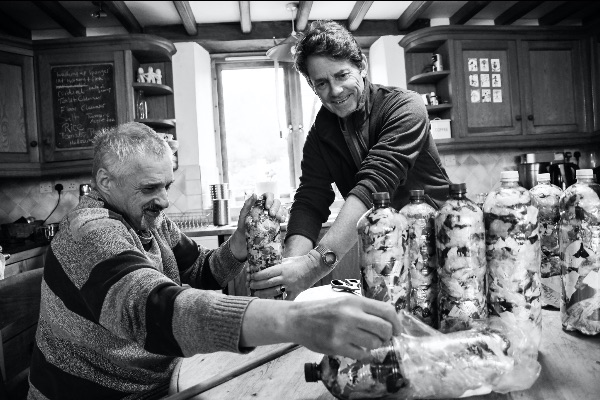Ecobricking

Ecobricking
Every Friday morning, Mitchell (M) and Reid (J) are ecobricking in High Farm kitchen, sometimes assisted by Arnold (J). An ecobrick is a brick used to make furniture, raised walkways, even walls, AND it disposes creatively and responsibly of plastic waste. You can google all this stuff, but let Mitchell M fill you in on the High Farm operation.
“Michael, what do we need?”
“This!”
“What is this?”
“Plastic!”
“And?”
“Plastic bottles!”
“What else?”
“A rod!”
“What kind of rod?”
“A eurythmy rod!”
“Not necessarily, though in our case, a very special eurythmy rod that unscrews in the middle to make two shorter rods. The rod is for tamping down the plastic inside the bottle. Anything else?”
“……………Scissors!”
“Yes, because the plastic has to be cut up small enough to go into the bottle and pack down tight. And how heavy do the bottles have to be?”
“I don’t know.”
“0.66kg for a 2 litre bottle.”
“Phwoar!!”
“I know. That’s why we’re having to keep packing the ones you thought were full because they haven’t hit the weight yet.”
“Where are we taking them?”
“At the moment, the nearest depot is in Darlington.”
“We should go! How many have you got in Castle House?”
“Not sure – maybe 12 or 13.”
“We need more!”
“Better get cracking then.”
As we work, we discuss the problems of how to put on a performance of Shakespeare’s Macbeth under Covid conditions, who’s going to be in it, where it’s going to be performed and how much we’re going to charge. The project hasn’t really got off the ground yet because WE NEED MORE PEOPLE! However, conversation lightens what is an incredibly tedious task. It takes us an hour and a half to make one ecobrick. Then again, the tedium is a mild but well-deserved payback for the absurdity of having created this much plastic waste in the first place.
A few tips:
Make sure you start tamping down the plastic before you shove too much in. If you don’t, you can end up with the top tightly packed and the bottom still loose. The bottom of most bottles is dimpled and you have to make sure no air pockets are left in those nooks and crannies.
Watch out for those bottles with a waist. If you don’t pack down the lower half tightly, before you get to the waist, it’ll be too late to do it when you’re packing the top half because the waist will cause a logjam. Sheer sided bottles are easier.
Make sure the plastic is clean. Foodstuffs will decompose, creating gas – you could have an explosion!
Don’t overdo it with the scissors. A really fine plastic bag will go in entire and pack down nicely.
Not everyone will have access to a eurythmy rod, but you do need something with a bit more heft than a wooden spoon, and something at least one and a half times the length of the bottle.
Although the jury is still out on the long-term viability of ecobricks, it is, at very least, an effective means of compacting and containing loose plastic waste. You also get to know different plastics, some of which one can actually see fragmenting into miniscule particles as you cut or tear it – micro-particles that are ending up in air or water. And, in our restricted circumstances, it is a very worthwhile and socialable household workshop. Give it a try.
Jonathan and Michael